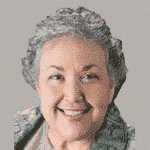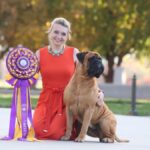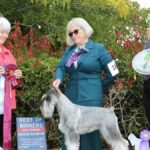Long ago, and in a faraway galaxy… no, not really. It was more like 1975 at the Greater Miami DC show at the now-gone Dinner Key Auditorium in Coconut Grove (Miami), this writer entered a real dog show ring for the first time.
The judge, Edith Nash Hellerman, kindly stopped me at the ring entrance and put all the dog’s lead into my left hand. She then sent me around the ring with my 6-9 Month Puppy Basset Hound dog, “Jolly.” At least I knew I had to make a counter-clockwise circle, as I had watched how she judged the previous breed. Plus, showing some halter horses during my teen years reminded me that I needed to keep the animal between the judge and myself. But that triangle? That was too hard for this novice to grasp! Why couldn’t I do a straight line like I did with a halter horse?
Recently I had a young woman come into my ring with a lovely Greyhound bitch. She held the lead in both hands and the collar was half-way down the bitch’s neck. It was déjà vu yet again. I asked her if this was her first time exhibiting, to which she answered in the affirmative. The next thing I said was “Let’s make this a fun time.” That put a smile on her face.
I showed her how and where to place the collar on the neck and how to hold the lead bundled in the left hand, and finally, I asked her to go around. She asked whether to the right or to the left. She went around to the left as I had instructed. She completed the left-handed circle in the familiar mincing-running steps that most novices start off with before they learn cadence and pacing with their dog. She attempted to set up her bitch for an examination, but it was futile as the bitch kept turning her head to me with her body following.
I showed the lady how to brace her leg against the bitch’s loin so that I could finish the exam. I asked for a down and back, and instructed the lady as to the corner to which she should aim and return to me, at the trot. She put the collar in its proper place before taking off, but both hands were still on the lead. (Fifty percent retention is not too bad when you are just learning!)
As I asked her to stand at the first-place spot and gave her single Breed entry the appropriate ribbons, I asked her if she knew of any dog handling classes, to which she answered, “No.” I could hear a woman standing ringside say, “I teach handling classes. I’ll talk to her.” Fantastic!!!!! Sometimes I’ll suggest to the exhibitor that they contact certain individuals for help with handling or grooming/trimming lessons. Most professional handlers and seasoned breeder-exhibitors have been quick to help in those situations.
Remembering that we likely started in the same situation, we owe it to those exhibitors to help them learn how it’s done and why. It only takes a few extra seconds or minutes, and the lesson and memories can last a lifetime.
That same day, a teenager showed a dog to me in a breed that requires a set-up of the front legs so that the feet are much closer together than the elbows, displaying a V-shape from elbows to feet when seen from the front. She put the dog on the table and proceeded to place the front legs parallel, from the elbows down to the feet as viewed from the front. I could see her doing this and, as I approached for the exam, I asked her if she had ever shown this breed before.
It was evident that she had shown dogs before, as she was poised, had correct collar placement and lead-handling skills, and gaited her exhibit at the correct speed for the breed. She informed me that she had not exhibited this breed before. I proceeded to show her how this breed’s front legs are placed when on the table, and how they should stop when they come back to the judge from gaiting. The smile on that young lady’s face was priceless!
Too often, novices who have had a few ring experiences mimic what others are doing and that may be wrong for the breed—or for their dog, specifically. How often have we seen a neck and head held so high that the exaggerated separation of the shoulder blades is palpable under the hand? It takes all of three seconds to put the dog’s head and neck into a natural position and tell the exhibitor why you are doing that.
When the class is completed, I ask the exhibitor to come back after the breed is done judging or the set of breeds is completed. At that time, I ask the exhibitor to put one hand on the withers and move their dog’s head and neck up and down with the other hand so that they can feel the lateral movement of the blades as the neck is moved through various lower and higher positions. This serves two purposes. The exhibitor learns what is optimum for their dog as well as feeling what the effect of differing postures are on the skeleton and its muscular attachments.
Most novices (and some experienced exhibitors as well) are not conscious of how their movements, especially with bait in hand, can affect a dog’s positioning for exam and gaiting. How often has an exhibitor held bait right in front of the dog’s mouth as it is approached for the head exam, only to have the dog follow and go for the bait while the judge is trying to examine the head? If it is a table or ramp breed, I either ask the exhibitor to put away the bait or hold it over and behind my left shoulder.
That way there is no obstruction of the dog’s face and the dog isn’t going for the bait. Most are also not aware that feeding a dog bait, rather than using it as a point of focus, during an exam causes the dog’s body to lurch forward and backward during the exam. Again, I ask the exhibitor to put away the bait until the exam is completed. Some dogs are enticed with bait as they gait around the ring, much to the dog’s detriment as they are thrown off balance while arcing the spine to get to the bait. We aren’t showing dressage horses that bend through corners of a dressage arena, where the spinal bend through the corner is desirable.
If the dog’s gaiting is so off balance that the gait cannot be effectively evaluated, I ask the exhibitor to put away the bait while explaining why I’m asking them to do so. The exhibitor is asked to redo the pattern and, more often than not, there is a great improvement. It even surprises the exhibitor that gaiting can be done without bait!
There have been numerous novice exhibitors who have come into my (and other judges’) rings over the years and, hopefully, will continue well into the future. Remembering that we likely started in the same situation, we owe it to those exhibitors to help them learn how it’s done and why. It only takes a few extra seconds or minutes, and the lesson and memories can last a lifetime.









